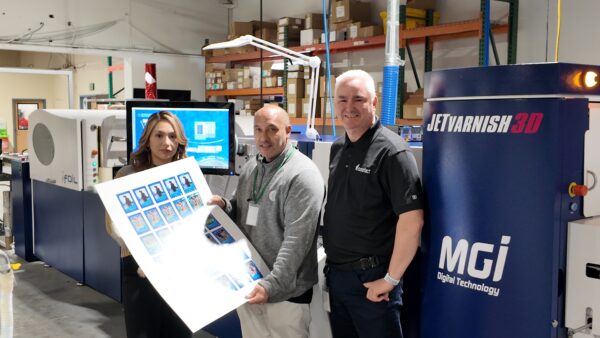NEXERA President Wes McArtor Discusses Company’s New Imaging Device Billing Model
In April, NEXERA (formerly BEI Services) released what it described as the industry’s first iDaaS (Imaging Device-as-a-Service) model for dealers. The company demonstrated its device-based billing (DBB) model at Konica Minolta’s recent dealer meeting in early March and will be at industry events throughout the year showcasing this new program. The following conversation with NEXERA’s’ President and founder Wes McArtor examines what’s new and unique about this program and how dealers can benefit from it.
For readers unfamiliar with NEXERA, the company provides benchmark device data and integrated service operations performance software solutions to control and optimize technician parts and labor expenses. It recently acquired Business Systems Consulting, expanding its offerings beyond traditional service. As a result, it now provides all-inclusive data integration for the dealer community, encompassing sales, service, finance, and administrative management.
CR: Can you give us a quick primer about your device-based billing model and share your inspiration for its development?
McArtor: HP is one of our customers and we have been hearing about DaaS from HP for a while. They were struggling with it and queried us on how to do it. That conversation sparked an idea that I could use my service data to model a program that would allow a dealer to price out the specific volume at a flat-rate model. Originally, I thought, well, this is easy, I’ll just take cost per copy and multiply it by a specific volume and that’s the number. But it doesn’t work that way because volume has a very specific impact on costs. While volume and toner are very linear in the way cost moves with it, parts and labor don’t move a hundred percent linear with volume. It does go up, obviously, but it doesn’t go up at the same level as toner, for example.
Unlike other flat-rate models, we’re very surgical, so we’re looking for a very specific expectation as it relates to page volume. The customer is essentially contracting for, let’s say 2,500 pages a month on a color device or a black and white device. That’s what they’re paying for. In addition to buying or leasing the equipment, they’re really buying that output. Our tool allows us to accurately predict what it is going to cost””toner, parts, labor, everything””to get that 2,500 pages a month at a specific margin expectation.
We’ve been modeling this since last October, trying to get the math to work and get to the point where we could feel confident with it. We’ve had it in Beta test since January and the dealers who are using it say it’s dead on and working exactly the way it needs to work.
CR: How do you view the initial opportunities for this?
McArtor: Obviously, we’re in a slow-to-change industry. People don’t like the idea of making change, but what’s accelerating the change is Konica Minolta’s program. Most of the dealers that I have, that are contacting me, are ones who going up against them in a bid situation and they don’t know how to do it. Konica Minolta saw that happening and so they basically endorsed our program for their dealers in order for them to have a version of that program. At Konica Minolta’s national dealer meeting in Newport Beach, everybody on stage was basically saying if you want to offer a program like this, go to BEI.
CR: Do you see this expanding to other manufacturers?
McArtor: Inevitably, they’re going to have to play the game. Right now, Konica Minolta has been selective about the markets that they’ve been pushing this in, and they’re not pushing it across every product that they have. It’s gaining momentum. Obviously, the dealers that have been Beta testing it see this as a huge opportunity to not only increase profits, but the trend is we’re in an industry that is almost 100% profit driven by the number of pages the customer prints. While at the same time, we sell them document management solutions to reduce print. The only way to stop the bleeding is to get these customers on a flat rate model that allows us to stem the bleeding that’s coming from the decline in print, then get aggressive about document management solutions and rules-based printing to reduce print or control print. And then focus on how much cost we can remove from the back end of the process by eliminating meters.
When you look at the average dealer, 12 to 17% of the meters they have in the field are bad. And that bad data creates invoicing issues when you’re billing with meters. You’re either billing them too little or billing them too much. You’ve got to reinvoice them, you’ve got to credit it, and you’ve got to reconcile it. If you could remove a significant portion of that cost on the back end, even if your revenue stays the same, you’d make more money.
CR: When you say that Konica Minolta is testing it with some of their products, is that what the dealers who are beta-testing it are doing as well?
McArtor: It varies. There are some dealers that are in using it on a one off against a specific bid situation where they’re competing with a flat rate-type program. More progressive dealers are aggressively transitioning their Managed IT customers who are already in a user- or a flat rate-type model and who also are print customers to that model to simplify billing. And then they’re also testing it in new customer acquisition. They’re still a little reluctant to convert existing print-only customers to that model. Most of it stems from a fear that if they stopped charging them for print, for some reason they’re going to start printing differently than they did before. That’s the number one thing I hear all the time: If we don’t charge them for color prints, they’re going to start running edge to edge full color photo albums and then we’re working to get hosed on toner.
CR: And when you hear them say that, how do you respond?
McArtor: Ninety percent of the end users who print don’t know how they’re being billed and what we’re changing is the billing method. The odds of them changing their behavior because you changed the billing method to me is remote. Second, it’s very easy to put fair play clauses in a contract and simply say, if your print volume or your toner consumption increases by a certain percentage, we can adjust the flat rate for that model to accommodate that. That’s real straightforward. It’s not hard to monitor volume. It’s not that we’re not collecting meters, we’re just not using them for billing. We’re just using them now for auditing.
CR: Do you see a point when this is the only billing model that’s being used in the industry?
McArtor: When the conversation started, I believed that it would probably take five years or maybe a little longer than that to transition to this type of a billing model. I think it’s going to happen significantly faster than that because there are only small pockets where this program won’t work. I would never put this in a print for pay environment or a production print environment because the person who’s using the product is oftentimes the same person who was involved in the purchase of the product. They understand cost control. And if you don’t think that’s true, look at what production print does with 11 by 17. They print 11 by 17, then cut it in half because they know they’re only getting charged one click. I would never put a flat rate model in those kinds of environments, and there may be even a few school districts or specialty print applications where I would suggest this isn’t the right way to go. But the data suggests that almost 80% of the installed base that we have, which is a little over four million devices, almost all of those machines could be done in a flat-rate model and the dealer would walk away making more money.
CR: When we talk a year from now, where would you like to be with this?
McArtor: I suspect we’ll have 50 or 60% of our customer base using this model at some level before the end of the year. We just launched it this month, and just in the first week, signed up six dealers. If enough dealers start to do it or start competing with it, that drives everybody else to compete with it as well. I don’t expect every dealer will use it across their entire product line, but I think there’s some very specific applications, A4 works exceptionally well, MPS works exceptionally well. I think there’s a good population of A3’s that this will work really well with. The higher end–75-, 80- copy a minute machines””are probably not that place. But when you look at a dealer’s overall placements, every dealer that I’ve shown this product to, literally 60 to 75% of their installed base is running less than 5,000 pages a month already. That’s a perfect place for an iDaaS model.
CR: I imagine wherever BEI Services shows up this year, you’ll be talking about this?
McArtor: That’s correct. We’re building audit tools to reprice existing customers. With the tool as it exists today, I can look up an existing customer number, look at all their equipment, their volume, and reprice them on a flat-rate model almost instantly.
Access Related Content
Visit the www.thecannatareport.com. To become a subscriber, visit www.thecannatareport.com/register or contact cjcannata@cannatareport.com directly. Bulk subscription rates are also available.




